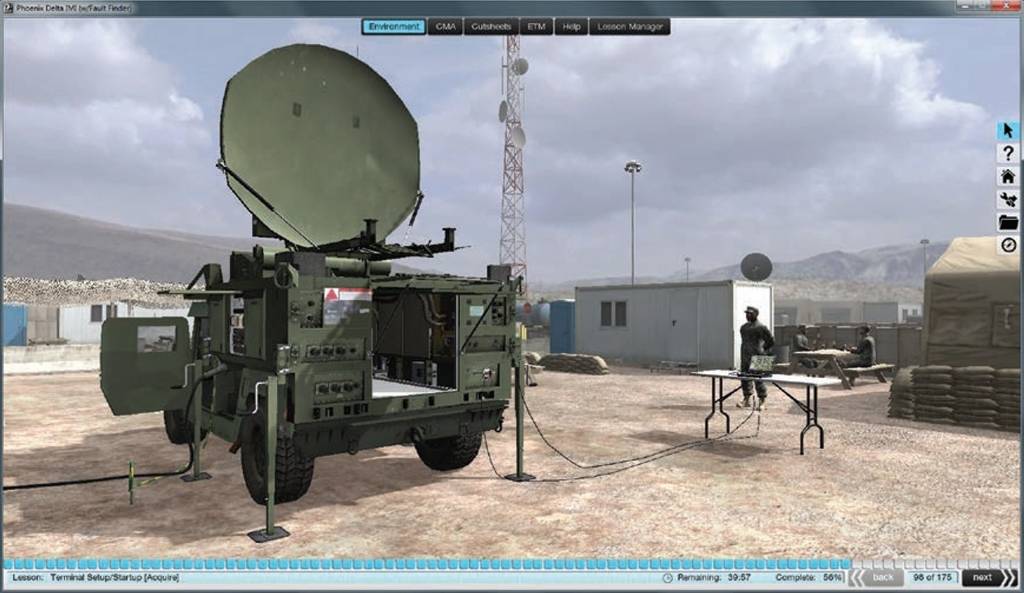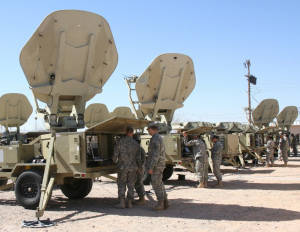Today’s Soldiers have grown up in the digital age. They play video games that enable friends and even strangers to team up online to slay aliens, combat terrorists and save the world. They take advanced high school and college classes online, and their smartphones are almost an appendage. “Death by PowerPoint” is no longer an effective means of training, especially on the Army’s advanced network and communications equipment. Soldiers are now learning faster and more efficiently, immersed in operational scenarios within virtual training environments and using the power of their own new network equipment to defeat the enemy. As the Army continues to modernize its tactical communications network, it is also shifting the network training paradigm: Instead of tailoring the training to new equipment, it is tailoring the training to the Soldier.
The Army’s network reaches across the entire U.S. and coalition force, yet it must be taught in a way that best targets a specific military occupational specialty (MOS). Training Soldiers to use the network virtually is no longer the wave of the future; it is quickly becoming today’s reality.
The old training paradigm had Soldiers undergoing weeks to months of new equipment training (NET) for Warfighter Information Network – Tactical Increment 1 (WIN-T Inc 1), the Army’s tactical communications backbone, in a traditional classroom environment with instructor facilitation, followed by hands-on equipment instruction.
A WIDE-OPEN ‘CLASSROOM’
The new approach transforms that classroom into a cost effective, paperless environment with global access, using the Internet, smartphones, tablets and personal computers to teach the ins and outs of the WIN-T network and its corresponding satellite equipment. Simulation training products are also very important to Army Reserve and National Guard communities to enhance individual and collective training opportunities.
The project manager (PM) for WIN-T within the Program Executive Office for Command, Control and Communications – Tactical (PEO C3T) is also working with the U.S. Army Signal Center of Excellence at Fort Gordon, GA, and Fort Gordon’s LandWarNet eUniversity to provide WIN-T training materials and technical manuals online so that Soldiers can access training 24/7 and train on their own timelines. The Common Access Card-enabled LandWarNet eUniversity, the Army’s online presence for command, control, communications and computers (C4) sustainment and training, contains information on how Soldiers can deploy and operate WIN-T and other C4 systems from start to finish. This pool of information is constantly available for Soldiers to refresh their skills. Several WIN-T Inc 1 simulation training pilot projects are in the works, all supported by a joint venture with support from PM WIN-T, the U.S. Army Communications-Electronics Command’s Logistics Readiness Center, equipment vendors and the Training Division at Fort Gordon.
PM WIN-T is starting its Inc 1 virtual training journey with several smaller pilot projects that include network operations and information assurance tools. As a follow-on to these pilots, the PM plans to expand NET simulation training throughout WIN-T Inc 1B, the updated capability baseline that improves the network’s security, efficiency and interoperability with WIN-T Inc 2. Simulation training is also planned for WIN-T Inc 1 end of life (EOL), which addresses technology for refresh of obsolete equipment.
During classroom instruction under the old training model, Soldiers who learned at a slower pace often were not willing to hold up the class in order to catch up, despite the detriment to their own knowledge base. Simulation training provides self-paced instruction; Soldiers can work at their own speed and achieve a more thorough grasp of the curriculum.
During WIN-T Inc 1 NET, Soldiers take the simulation training online and meet regularly with a facilitator to pose any questions and discuss the material, greatly reducing classroom time. WIN-T Inc 1 simulation will also include collective training events in which students of different MOSs can interact, using the equipment in various real-world signal scenarios via the schoolhouse’s collective training simulator, the Network Nodal Management System.
Following WIN-T Inc 1 NET simulation training, Soldiers will receive hands-on training with actual equipment. Simulation as a part of NET is not meant to replace hands-on training, but can reduce hands-on training time and costs by ensuring that Soldiers already have a good understanding of the equipment and how it operates within the network.
The schoolhouse has developed the baseline for the WIN-T Inc 1B NET and EOL virtualization programs. Once the curriculum is established, the PM is planning to establish standard operating procedure (SOP) for standing up new simulation training requirements for WIN-T Inc 2 and other new equipment programs. In the future, whenever the PM needs to develop a new simulation training package, the process will already be in place to produce any new virtual training tools using a standard work plan. The SOP is expected to reduce contract processing time for new training modules, which can be turned around quickly and efficiently.
Both increments of WIN-T are deployed today as part of the Army’s interoperable tactical communications network architecture. WIN-T Inc 2 adds mobility to the network, with network-equipped vehicles that provide the mobile communications, mission command applications and situational awareness that commanders need to lead from anywhere on the battlefield. Currently, a simulation package is part of training for the WIN-T Inc 2 Tactical Communications Node, but the PM is working to develop simulation packages for all of the WIN-T Inc 2 configuration items to provide Soldiers with an information reservoir they can use to refresh their knowledge whenever needed following NET. The PM is also developing maintenance task simulations so that Soldiers can reinforce their maintenance training to better support the WIN-T systems and reduce reliance on field service representatives (FSRs).
SATCOM TRAINING MEETS ANDROID APP
PM WIN-T also employs simulation training for many of its ground satellite terminal programs. It recently fielded new training and simulation software for interactive multimedia instruction (IMI) for the Phoenix tactical satellite terminal. Initial development of the IMI was spurred by a shortage of physical Phoenix terminals to meet the training requirements of satellite communication systems operator-maintainer (MOS 25S) Soldiers at Fort Gordon.
The result is a highly interactive simulation environment that incorporates multimedia elements and scenario-based learning. The training immerses Soldiers in a 3-D operational environment and allows them to virtually set up, tear down, operate and troubleshoot the AN/TSC-156 Phoenix Quad-Band Satellite Communications system. Since inception, the Phoenix IMI software has been continually updated to keep pace with upgraded versions of the Phoenix terminal. There is also a version of the software to support the Marine Corps’ C model Phoenix.
This valuable training tool will soon be even easier to access. PM WIN-T’s Phoenix team is leading the way through the development of a mobile Android tablet based simulated training environment for the Phoenix IMI, with fielding expected in the spring of 2015, which could set the standard for lightweight, pocket-sized training aids and materials. The IMI training software was also placed on LandWarNet’s eUniversity portal to allow signal units and Soldiers to access and download it to their desktops, for refresher and familiarization training at home or in garrison. As it does for all of its training packages, PM WIN-T continues to work with the schoolhouse to obtain feedback from Soldiers and trainers to keep improving capability.
MEASURABLE EFFICIENCIES
The Army’s WIN-T simulation training efforts are expected to increase efficiencies in training time as well as equipment and personnel costs. Simulation training cuts down classroom time, hands-on training and unit disruption. Units will benefit from training packages that can be loaded into military-issued personal computing devices and smartphones to train or refresh training from the field without having to travel to a major Army simulation facility or back to the schoolhouse. This decreases reliance on FSRs to provide support before NET, during pre-deployment refresher training and through over-the-shoulder refresher training in theater. There is also a cost saving in terms of equipment downtime, since using and moving these terminals in the field requires personnel and satellite time as well as fuel and maintenance.
CONCLUSION
The Army’s network simulation training packages resemble some of the most popular warfighting games available on store shelves today. The packages give the Army more options in training curricula, and Soldiers can experience a virtual realistic environment without having to draw on limited resources such as fuel, generators and airtime.
The simulation holds Soldiers’ attention and interest, and improves comprehension and retention far better than dry, antiquated presentations. In realistic operational scenarios, Soldiers learn how to operate the equipment and how to use it collectively in the heat of battle, enabling them to employ the network to its fullest capability while performing their mission-essential tasks with the utmost proficiency. Being in the battle, without the battle, is a well-learned lesson in efficiency and readiness for today’s forces.
For more information, go to the PEO C3T website at http://peoc3t.army.mil/c3t/ and the PM WIN-T website at http://peoc3t.army.mil/wint/
MAJ NAIM R. LEE is PM WIN-T’s assistant product manager for satellite communications. He holds an M.A. in leadership and management from Webster University and a B.S. in computer science from Prairie View A&M University. He is Level III certified in program management and is a member of the U.S. Army Acquisition Corps (AAC ).
MS . CAROLINE MCCARTHY is the Readiness Management Branch chief for the product manager for WIN-T Inc 1. She holds a B.A. in business management and administration from Monmouth University. She is Level III certified in life-cycle logistics and Level II certified in program management and in life-cycle logistics. She is an AAC member.
DR. SAMUEL JOHNSON (USA , Ret.) is the training manager for WIN-T Inc 1. He holds an Ed.D. with a specialization in adult education from Nova Southeastern University, an M.A. in marketing from Webster University and a B.S. in journalism from the University of Kansas. He is a retired Army lieutenant colonel.
Source: Maj. Naim R. Lee, Ms. Caroline McCarthy and Dr. Samuel Johnson, “Training On The Virtual Net,” Army AL&T Magazine, 7/16/2014




